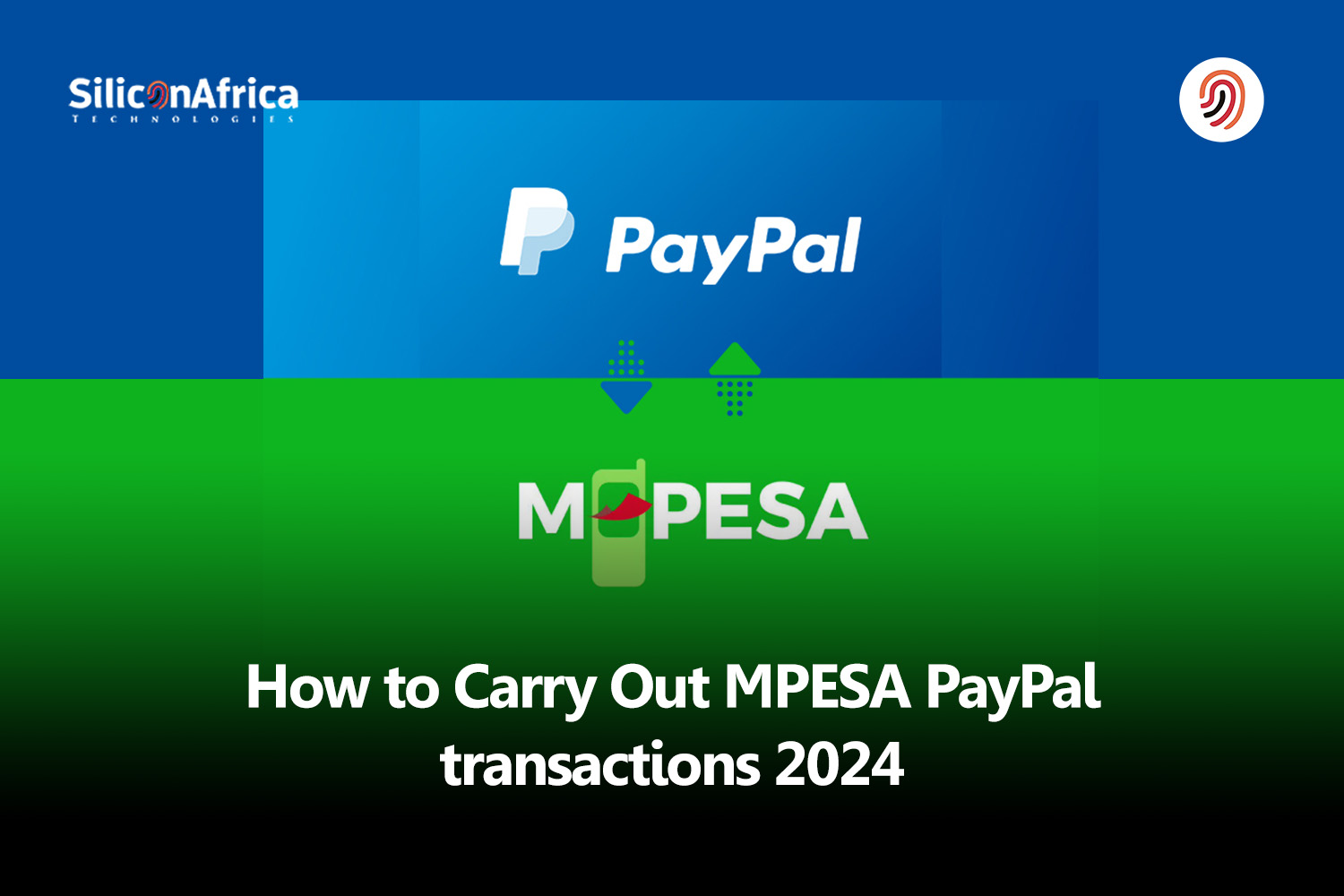Newsletter Subscribe
Enter your email address below and subscribe to our newsletter

More Africans are earning in foreign currencies through remote work opportunities and freelancing. One issue that has posed a major challenge is receiving payments from foreign companies into local accounts seamlessly.

Since these companies cannot pay in local currencies, African professionals must seek means to receive their income without any hassle. It is 2024, and the way we conduct payments online is becoming increasingly seamless and streamlined.
One that stands out is the payment integration between PayPal and MPESA which allows Kenyan users to manage their finances effortlessly.
While many foreign companies choose to use PayPal or other payment platforms to transfer money to other countries, this platform is only open to a few African countries, one of which is Kenya.
Kenyan users can move money between PayPal to MPESA money transfer service. Want to know how that works? In this article, we will guide you through the process of carrying out MPESA-PayPal transactions in 2024, just so you can make the most of both platforms.
MPESA PayPal service is a money transfer service that allows you to transfer money from your PayPal account to your MPESA account in Kenyan Shillings. You can also use this service to fund your PayPal account from your MPESA account.
This service is a result of the partnership between Kenyan telecoms company Safaricom and PayPal. With this service, Kenyans can easily transact – convert, and transfer in two currencies.
With PayPal quickly dominating the online payment landscape, some of its services remain inaccessible to many African countries for a couple of reasons.
While other African countries can pay for goods with PayPal, they cannot receive payments from other countries. This means that they must seek other payment alternatives.
The first step in making transactions between MPESA and PayPal is to set up an account on both platforms. You can sign up for a PayPal account directly on their website. For an MPESA, visit any of Safaricom’s agents across Kenya.
Once you are done with this step, all you need to do next is to link both accounts to enable you to do your transactions.
As earlier stated, once you have successfully registered on both platforms, you must link them together to enable you to move money between both accounts.
The following is a step-by-step guide on how you can successfully link your MPESA account with PayPal.
To avoid getting error messages when you’re linking your PayPal account with MPESA, ensure you use the same names across both platforms.
With your MPESA and PayPal accounts linked, you can either fund your PayPal from your MPESA account or transfer cash from your PayPal account to MPESA. We will explain how you can do both in the sections below.
With the MPESA PayPal transaction, users in Kenya can load their PayPal accounts using their MPESA accounts. With this, you can fund your PayPal with dollars by yourself. Follow the steps below to load your PayPal with your MPESA balances:
The most reliable MPesa to PayPal calculator available is conveniently provided on the same website used for withdrawing funds from PayPal to M-Pesa accounts.
This user-friendly tool simplifies the process: just navigate to the “top-up” section and input the desired transfer amount in USD from your M-Pesa account.
Upon clicking “calculate,” the converted amount will be promptly displayed in Kenyan shillings, along with the corresponding exchange rate utilized for the conversion. Remember that the MPesa to PayPal conversion rate fluctuates in response to changes in exchange rates.
Once you have the Kenyan Shilling equivalent of the desired USD amount ready for transfer from your eligible M-Pesa account, access the M-Pesa menu on your mobile device.
On the M-Pesa menu, select Lipa na M-PESA and then choose the Pay Bill option.
You will be asked to enter the business number. Enter the number 800088.
Next, input the mobile number associated with the MPesa account linked to the PayPal account you are loading funds into. Enter the amount you are transferring in Kes.
This represents the Kenyan Shilling equivalent of the USD amount you intend to use to top up your PayPal account.
Inputting your M-Pesa PIN confirms and authorizes the transfer from your M-Pesa mobile wallet to your PayPal account.
Once you’ve successfully loaded funds from your MPESA account to your PayPal account through the MPESA-PayPal link, you’ll also have the capability to withdraw money from your PayPal balance.
It’s important to note that withdrawals can only be made from your USD balance. Therefore, before initiating a withdrawal, ensure to log into your PayPal Kenya account and convert your balance to USD if necessary.
Follow these steps to complete a withdrawal from PayPal to MPesa:
3, Confirm the transaction to finalize the withdrawal process. According to PayPal to MPesa, it may take anywhere from 2 hours to 3 working days before the funds are reflected in your MPesa account. The duration of the withdrawal process can vary based on multiple factors, such as the amount being exchanged.
Similar to other mobile money services, there is a daily limit when loading your PayPal account using MPesa. The standard MPesa limits also apply to transactions involving PayPal and MPesa.
For each transaction, you can deposit or withdraw up to Kes.150,000. Additionally, the daily limit for transactions is Kes.300,000. If your business regularly conducts transactions exceeding these limits, you may need to explore alternative options.
When withdrawing funds from your PayPal balance, you’ll incur a fee of 3% of the amount converted from USD to Kes. Similarly, when topping up your PayPal account from your M-Pesa account, a fee of 4% of the top-up amount will be charged.
The PayPal to MPesa withdrawal service has provided a valuable solution for many businesses in Kenya, addressing the challenge of withdrawing funds efficiently.
Despite its benefits, there are certain considerations to keep in mind before utilizing the PayPal to MPesa service. Let’s explore some of these issues below.
For new PayPal users, it’s important to note that the initial payment you receive may be subject to a temporary hold. This precautionary measure is implemented to ensure that the sender doesn’t raise any disputes regarding the transaction.
During this period, the funds are held in escrow, meaning they are temporarily placed in custody until certain conditions are met or until the funds are cleared for use.
PayPal employs a risk-based algorithm to assess whether a payment should be held. The level of risk associated with the transaction influences the duration of the hold.
The funds are kept in the recipient’s account until the sender confirms the transaction from their end, at which point the hold may be lifted.
A significant challenge that African PayPal users have encountered in recent years is the lack of adequate local support. Unlike in other regions, there is no dedicated support team to address the specific needs of PayPal users in Africa.
When facing complex issues, users may prefer to interact with support technicians who are fluent in their local language and understand the unique challenges of their region.
PayPal is known for its substantial service fees, which can eat into your transaction amounts, especially for international transfers.
The terms of use for PayPal can be subject to change, leading to uncertainties and potential issues such as arbitrary account suspensions and restrictive transaction limits.
Some users may face difficulties with card rejections when attempting to link their cards to their PayPal accounts, which can hinder transaction processes.
Due to various factors such as account limitations, security concerns, or PayPal’s policies, users may encounter instances where they are unable to complete specific transactions, leading to frustration and inconvenience.
In conclusion, carrying out MPESA PayPal transactions in 2024 offers a convenient way to manage finances seamlessly. Key points to remember, include setting up both accounts, understanding transaction limits, and being mindful of associated fees.
MPesa, short for “Mobile Money” in Swahili, is a mobile phone-based financial service. It allows users to store, send, and receive money using their mobile phones. Initially launched in Kenya in 2007, MPesa has expanded to various countries, providing a convenient and accessible way for individuals to engage in financial transactions, even without traditional bank accounts. Users can visit MPesa outlets to deposit or withdraw cash, and the service has played a significant role in promoting financial inclusion, particularly in areas with limited access to formal banking services.
MPesa is used in several countries, including Kenya, Tanzania, South Africa, Afghanistan, Lesotho, the Democratic Republic of Congo (DRC), Ghana, Mozambique, Egypt, and Ethiopia.
MPesa works by allowing users, including those without bank accounts, to visit M-Pesa outlets. At these outlets, users provide cash to kiosk attendants, who then digitally transfer the equivalent amount to the user’s M-Pesa account. The cash collected digitally is securely stored in an M-Pesa trust account, facilitating a seamless and accessible mobile money experience.
Recommendations
How to Send Money Between Equity Bank & MPESA 2024